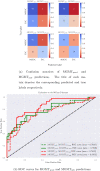Predicting the clinical management of skin lesions using deep learning
- PMID: 33833293
- PMCID: PMC8032721
- DOI: 10.1038/s41598-021-87064-7
Predicting the clinical management of skin lesions using deep learning
Abstract
Automated machine learning approaches to skin lesion diagnosis from images are approaching dermatologist-level performance. However, current machine learning approaches that suggest management decisions rely on predicting the underlying skin condition to infer a management decision without considering the variability of management decisions that may exist within a single condition. We present the first work to explore image-based prediction of clinical management decisions directly without explicitly predicting the diagnosis. In particular, we use clinical and dermoscopic images of skin lesions along with patient metadata from the Interactive Atlas of Dermoscopy dataset (1011 cases; 20 disease labels; 3 management decisions) and demonstrate that predicting management labels directly is more accurate than predicting the diagnosis and then inferring the management decision ([Formula: see text] and [Formula: see text] improvement in overall accuracy and AUROC respectively), statistically significant at [Formula: see text]. Directly predicting management decisions also considerably reduces the over-excision rate as compared to management decisions inferred from diagnosis predictions (24.56% fewer cases wrongly predicted to be excised). Furthermore, we show that training a model to also simultaneously predict the seven-point criteria and the diagnosis of skin lesions yields an even higher accuracy (improvements of [Formula: see text] and [Formula: see text] in overall accuracy and AUROC respectively) of management predictions. Finally, we demonstrate our model's generalizability by evaluating on the publicly available MClass-D dataset and show that our model agrees with the clinical management recommendations of 157 dermatologists as much as they agree amongst each other.
Conflict of interest statement
G.H. serves as a Scientific Advisor to Triage Technologies Inc., Toronto, Canada, where J.K. and G.H. are minor shareholders (
Figures






Similar articles
-
Radiomic and deep learning analysis of dermoscopic images for skin lesion pattern decoding.Sci Rep. 2024 Aug 26;14(1):19781. doi: 10.1038/s41598-024-70231-x. Sci Rep. 2024. PMID: 39187551 Free PMC article.
-
Computer algorithms show potential for improving dermatologists' accuracy to diagnose cutaneous melanoma: Results of the International Skin Imaging Collaboration 2017.J Am Acad Dermatol. 2020 Mar;82(3):622-627. doi: 10.1016/j.jaad.2019.07.016. Epub 2019 Jul 12. J Am Acad Dermatol. 2020. PMID: 31306724 Free PMC article.
-
A new deep learning approach integrated with clinical data for the dermoscopic differentiation of early melanomas from atypical nevi.J Dermatol Sci. 2021 Feb;101(2):115-122. doi: 10.1016/j.jdermsci.2020.11.009. Epub 2020 Dec 2. J Dermatol Sci. 2021. PMID: 33358096
-
Deep Learning Approaches Towards Skin Lesion Segmentation and Classification from Dermoscopic Images - A Review.Curr Med Imaging. 2020;16(5):513-533. doi: 10.2174/1573405615666190129120449. Curr Med Imaging. 2020. PMID: 32484086 Review.
-
Skin cancer classification via convolutional neural networks: systematic review of studies involving human experts.Eur J Cancer. 2021 Oct;156:202-216. doi: 10.1016/j.ejca.2021.06.049. Epub 2021 Sep 8. Eur J Cancer. 2021. PMID: 34509059
Cited by
-
Skin Type Diversity in Skin Lesion Datasets: A Review.Curr Dermatol Rep. 2024;13(3):198-210. doi: 10.1007/s13671-024-00440-0. Epub 2024 Aug 14. Curr Dermatol Rep. 2024. PMID: 39184010 Free PMC article. Review.
-
Predicting Mohs surgery complexity by applying machine learning to patient demographics and tumor characteristics.Exp Dermatol. 2022 Jul;31(7):1029-1035. doi: 10.1111/exd.14550. Epub 2022 Mar 3. Exp Dermatol. 2022. PMID: 35213063 Free PMC article.
-
Artificial intelligence-enabled precision medicine for inflammatory skin diseases.ArXiv [Preprint]. 2025 May 14:arXiv:2505.09527v1. ArXiv. 2025. PMID: 40463698 Free PMC article. Preprint.
-
The accuracy of artificial intelligence used for non-melanoma skin cancer diagnoses: a meta-analysis.BMC Med Inform Decis Mak. 2023 Jul 28;23(1):138. doi: 10.1186/s12911-023-02229-w. BMC Med Inform Decis Mak. 2023. PMID: 37501114 Free PMC article.
-
Artificial intelligence and skin cancer.Front Med (Lausanne). 2024 Mar 19;11:1331895. doi: 10.3389/fmed.2024.1331895. eCollection 2024. Front Med (Lausanne). 2024. PMID: 38566925 Free PMC article. Review.
References
-
- Bakheet S. An SVM framework for malignant melanoma detection based on optimized HOG features. Computation. 2017;5:4. doi: 10.3390/computation5010004. - DOI
-
- Grzesiak-Kopeć, K., Nowak, L. & Ogorzałek, M. Automatic diagnosis of melanoid skin lesions using machine learning methods. In Rutkowski, L. et al. (eds.) International Conference on Artificial Intelligence and Soft Computing, 577–585 (Springer, Cham, 2015). 10.1007/978-3-319-19324-3_51.
Publication types
MeSH terms
LinkOut - more resources
Full Text Sources
Other Literature Sources
Medical

